Loaded Baked Potato Salad
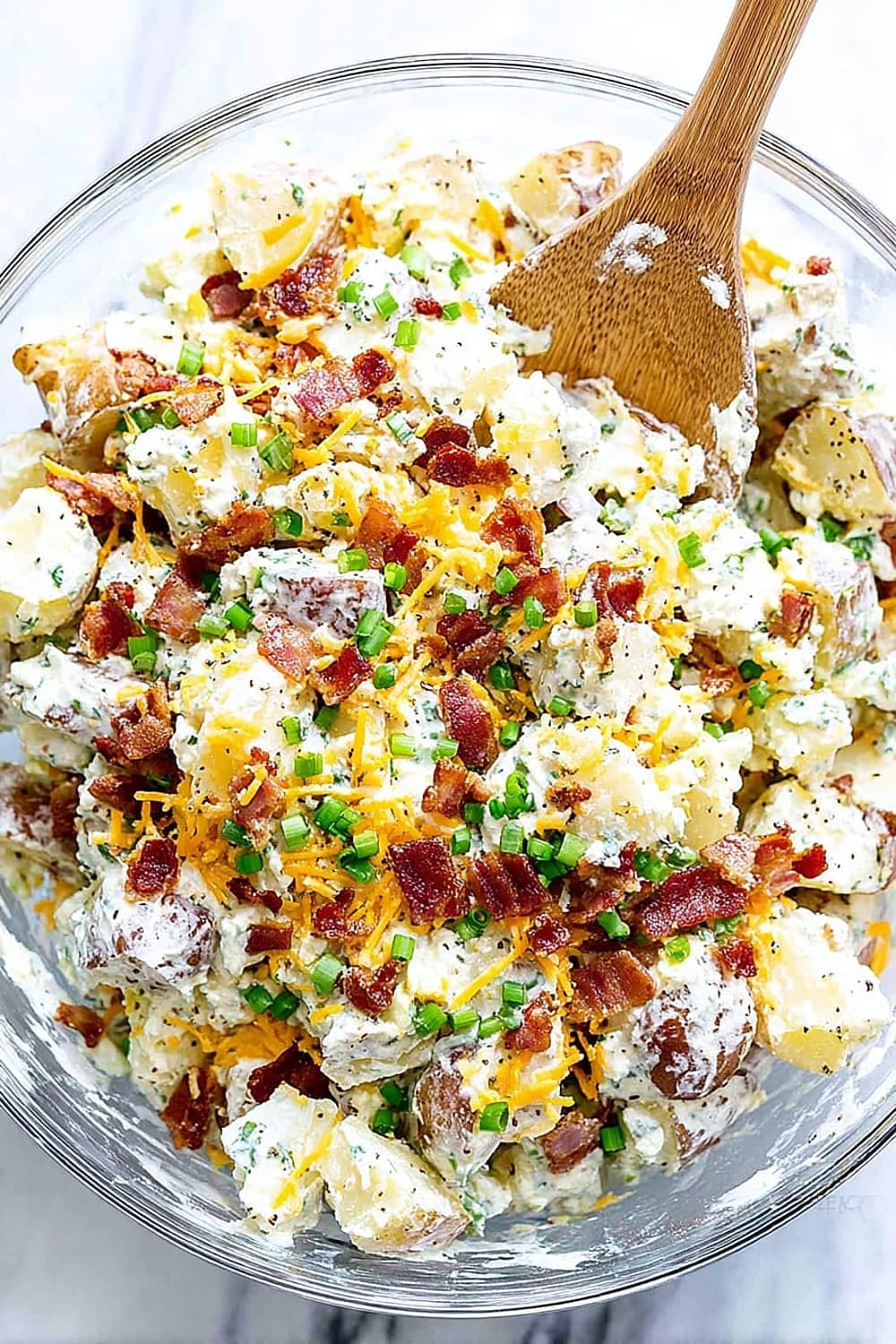
This recipe is basically the ultimate comfort food mashup that makes everyone wonder why they never thought of it first.
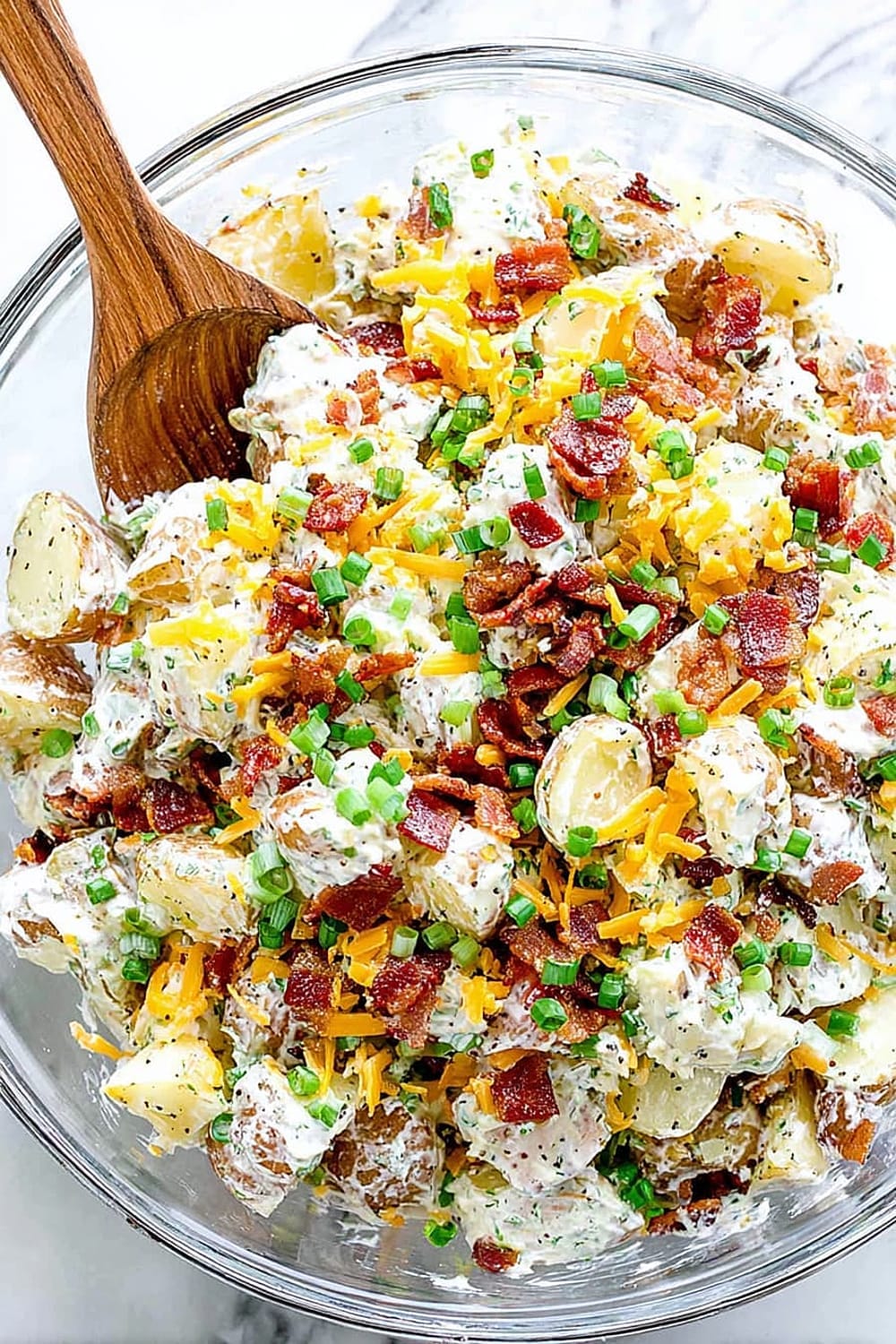
Picture all the creamy, indulgent goodness of a loaded baked potato transformed into the perfect make-ahead side dish that actually gets better as it sits.
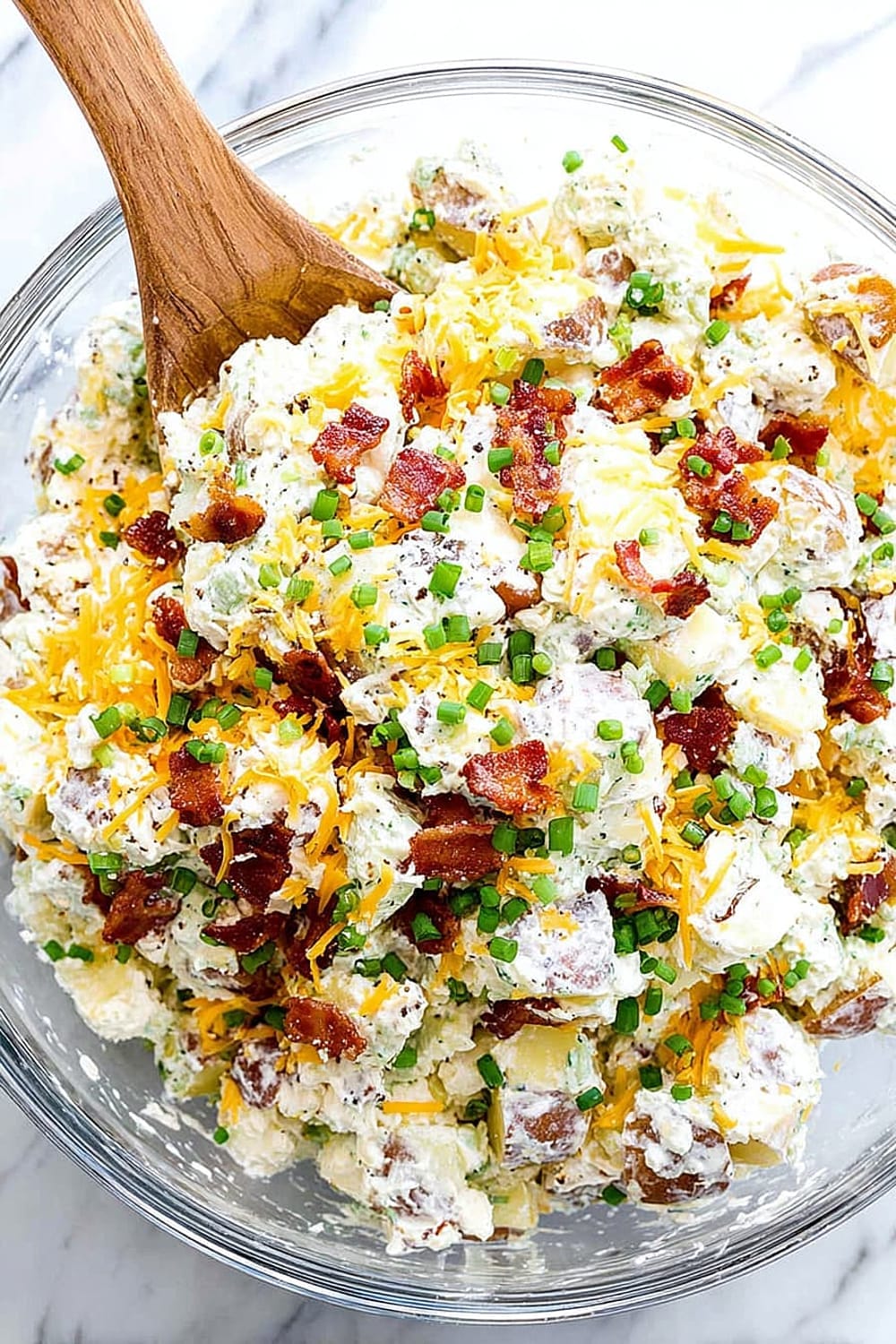
We’re talking fluffy russet potatoes roasted to perfection, then tossed with crispy bacon, sharp cheddar cheese, and fresh green onions in a tangy mayo-sour cream dressing.
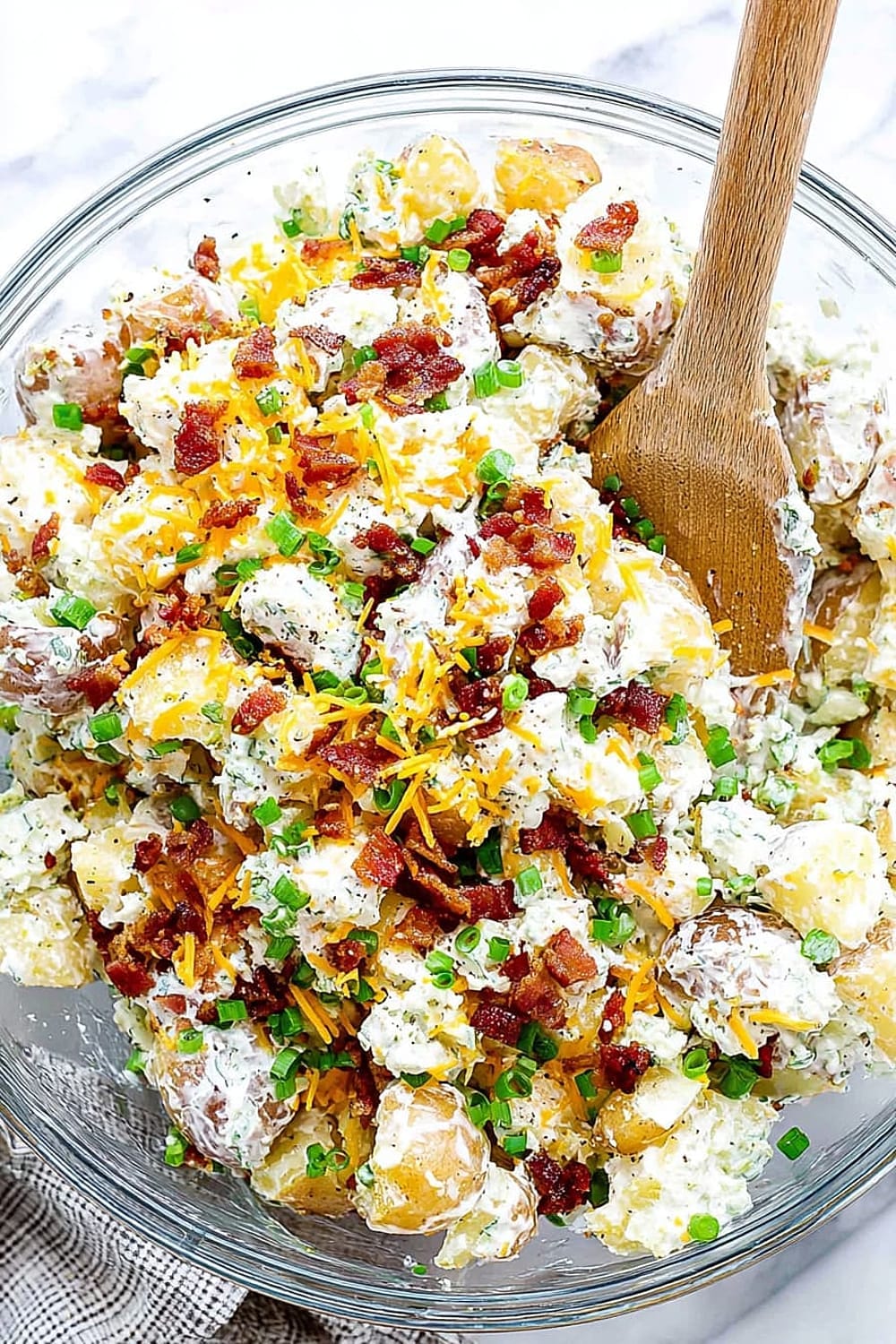
The secret weapon here is adding apple cider vinegar to the warm potatoes, which creates this incredible depth of flavor that elevates this way beyond your typical mayo-heavy potato salad.
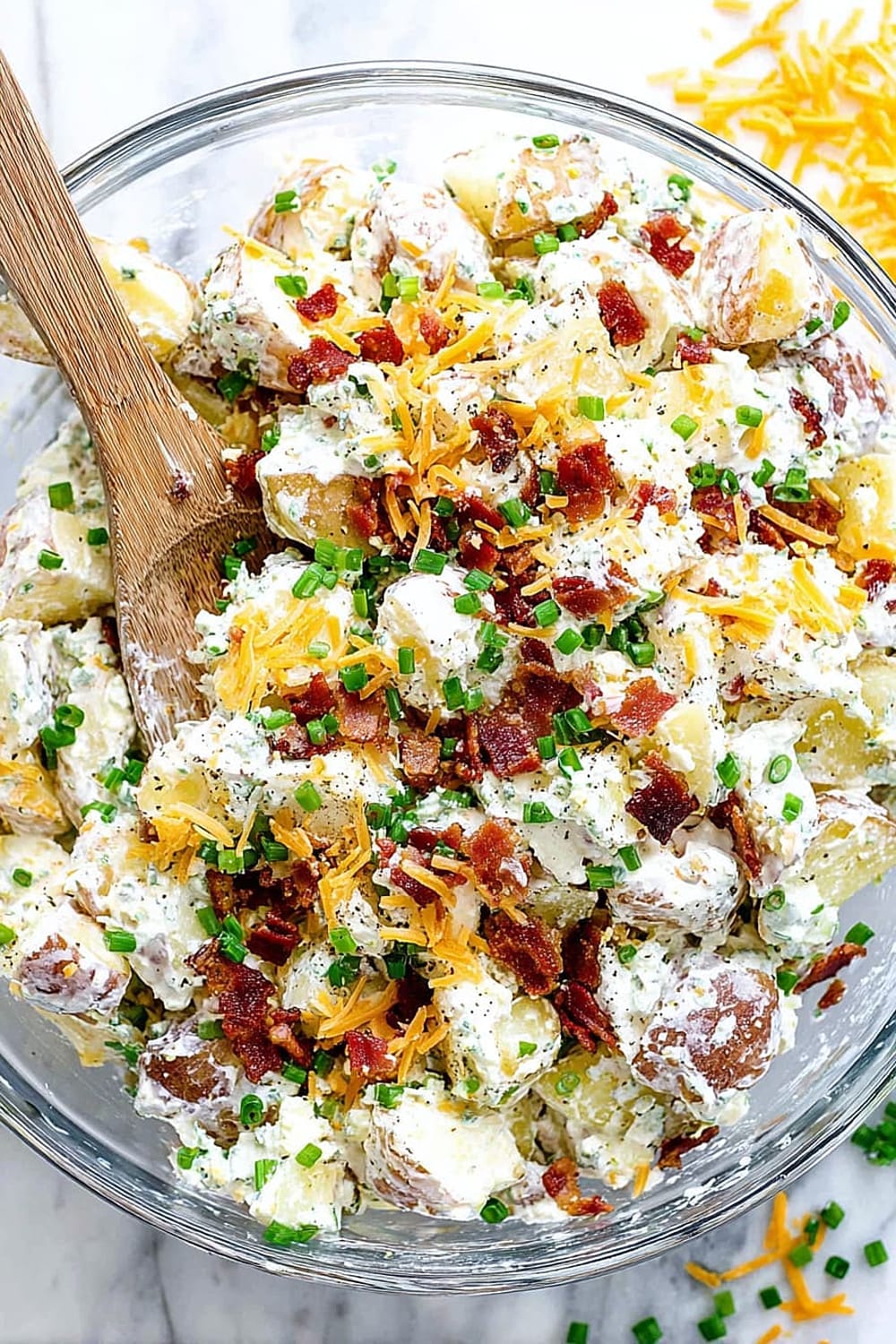
This is the kind of dish that disappears at potlucks and has people sliding into your DMs asking for the recipe.
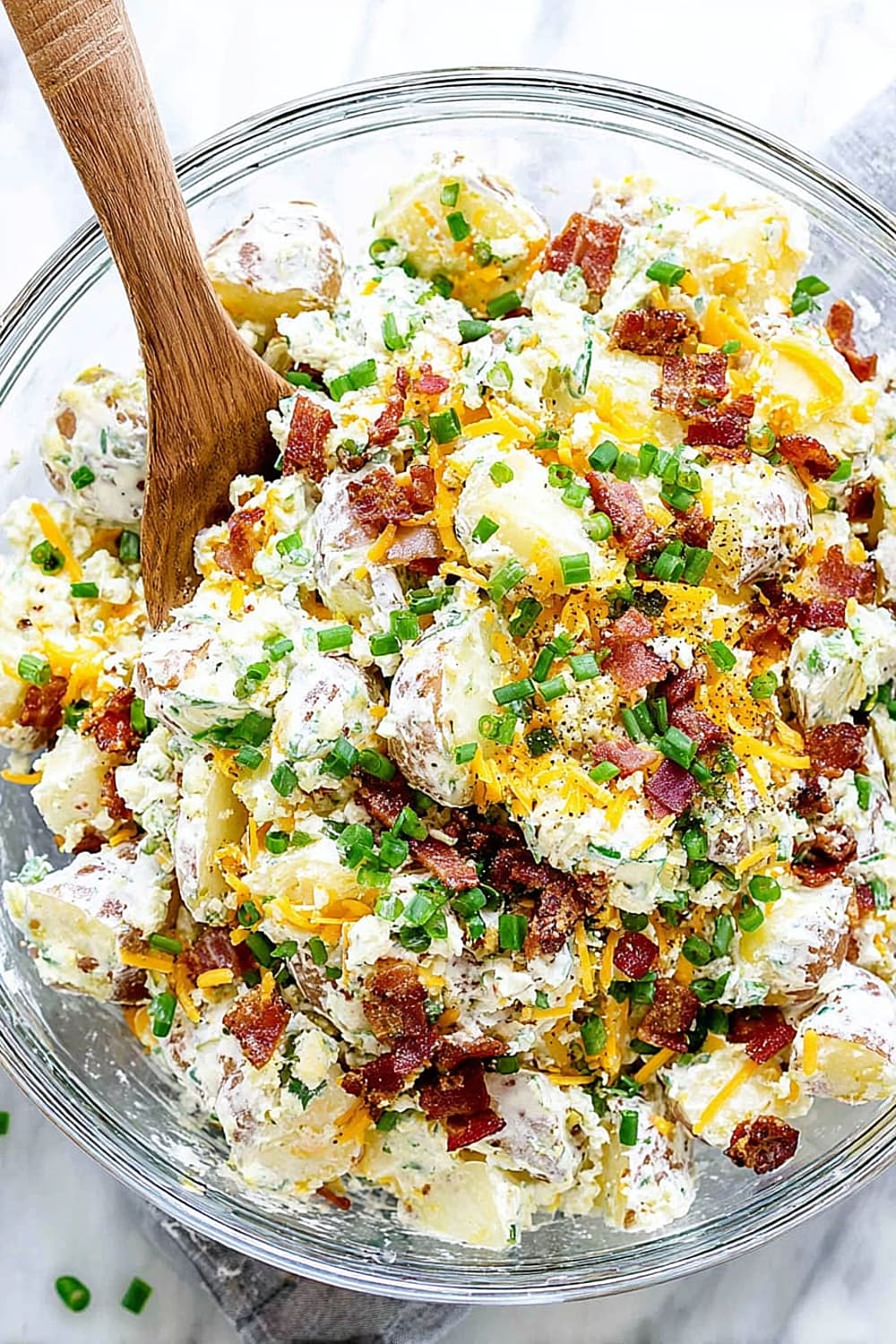
Plus, it’s completely make-ahead friendly, which means less stress and more time to enjoy whatever gathering you’re bringing this masterpiece to.
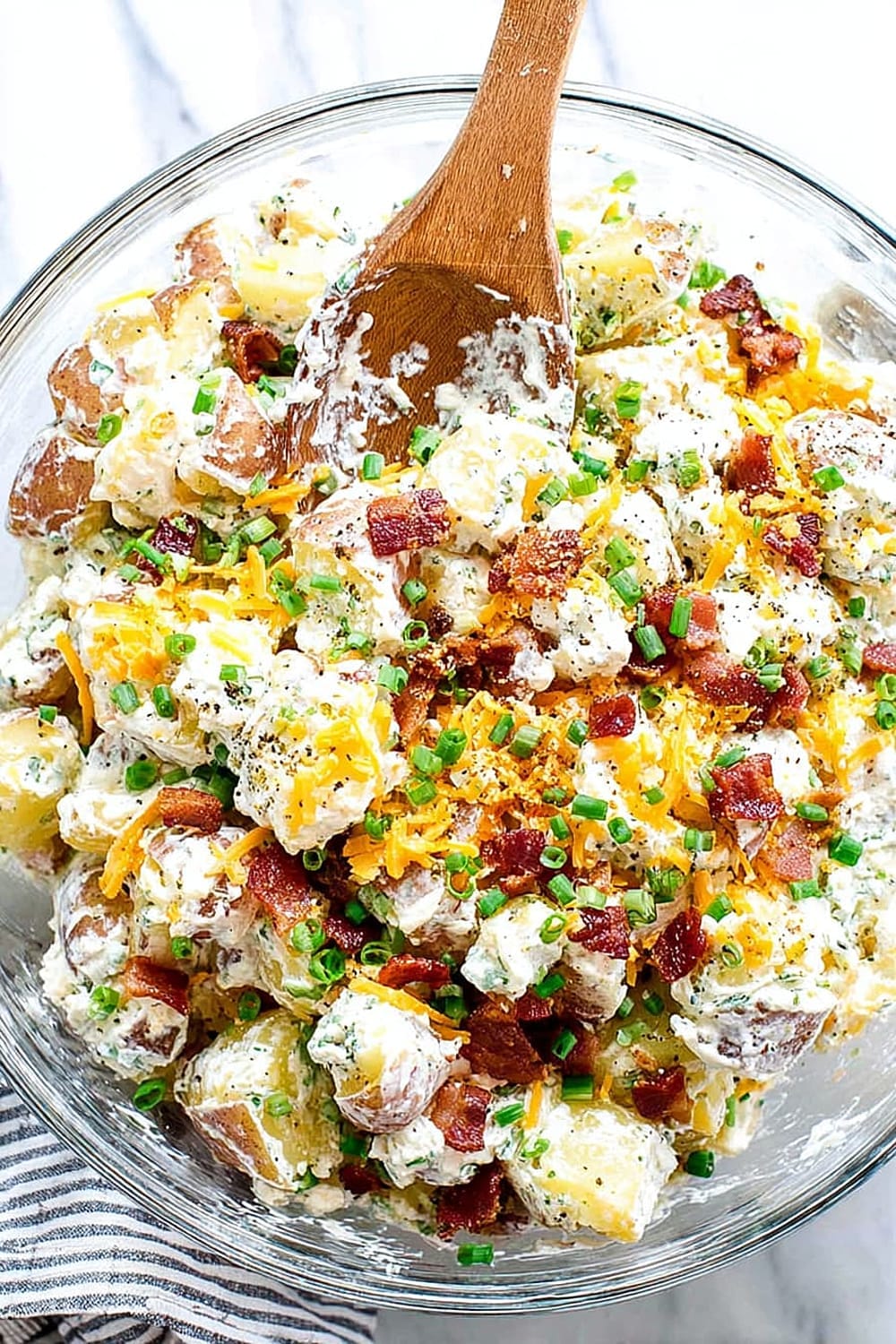
Ingredients
For the base
- 4 pounds russet potatoes
- 1-2 tablespoons olive oil
- 3 tablespoons apple cider vinegar
For the creamy dressing
- 1 cup mayonnaise
- ¾ cup sour cream or Greek yogurt
- 1 teaspoon kosher salt
- 1 teaspoon freshly ground black pepper
For the loaded toppings
- 12 ounces bacon, cooked, cooled and chopped
- 6 green onions, chopped
- 1½ cups medium cheddar cheese, shredded
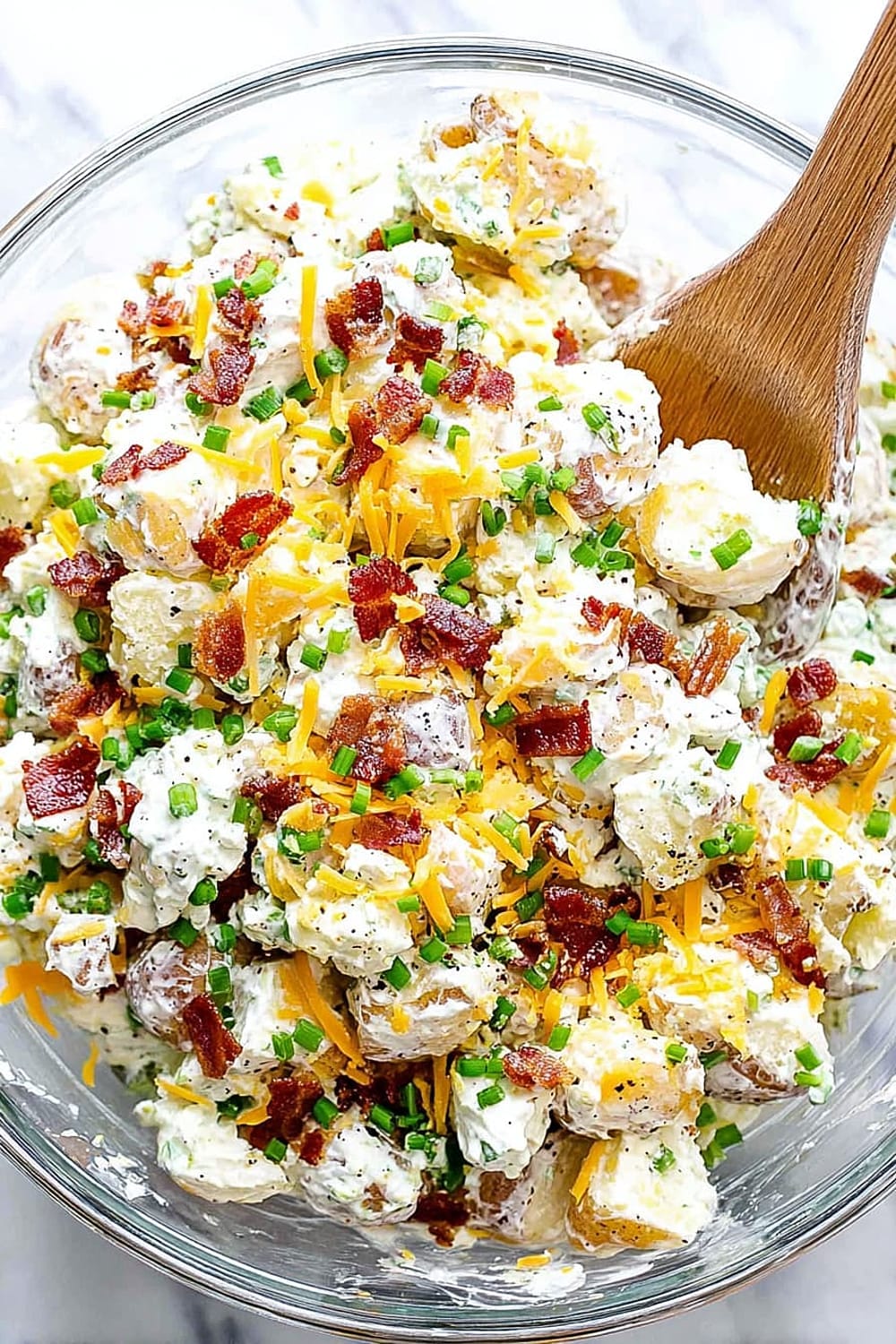
Instructions
Prepare the potatoes
- 1 Preheat your oven to 400°F (200°C) and position a rack in the center. Using a sharp fork or skewer, pierce each cleaned potato 4-5 times all around to prevent bursting during baking.
- 2 Place the pierced potatoes on a large baking sheet and lightly coat with 1-2 tablespoons olive oil, rubbing it into the skin. Sprinkle generously with kosher salt for that perfect crispy skin texture.
- 3 Bake for 50-60 minutes or until the potatoes yield easily when pierced with a cake tester or skewer. The internal temperature should reach 210°F (99°C) for perfectly fluffy interiors.
- 4 Remove from oven and let cool for 5 minutes until safe to handle. While still warm, carefully peel away the potato skins and cut the flesh into 1-inch chunks. Don’t worry if the potato flesh crumbles and looks shaggy – this rustic texture is exactly what we want for the best potato salad consistency.
Season and cool
- 5 Transfer all the warm potato chunks to a large mixing bowl. While the potatoes are still warm, sprinkle them evenly with the 3 tablespoons apple cider vinegar. This crucial step allows the potatoes to absorb the tangy flavor as they cool.
- 6 Let the seasoned potatoes rest for 15-30 minutes until completely cooled to room temperature. This prevents the mayonnaise from breaking when mixed in later.
Prepare the bacon and dressing
- 7 While the potatoes cool, cook the 12 ounces bacon in a large cast iron skillet over medium heat until crispy, about 8-10 minutes, or use the oven method for less mess. Drain on paper towels and let cool completely before crumbling into bite-sized pieces.
- 8 In a small mixing bowl, whisk together the 1 cup mayonnaise and ¾ cup sour cream until smooth. Season with 1 teaspoon kosher salt and 1 teaspoon freshly ground black pepper.
Assemble the salad
- 9 Once the potatoes are completely cool, pour the creamy mayonnaise mixture over them. Add the crumbled bacon, chopped green onions, and 1½ cups shredded cheddar cheese.
- 10 Using a large silicone spatula or wooden spoon, gently fold all ingredients together until evenly coated. Taste and adjust seasoning with additional salt and pepper as needed.
- 11 Cover and refrigerate for 3 hours up to overnight before serving. This chilling time allows all the flavors to meld together perfectly. The salad will keep in the refrigerator for up to 4 days in an airtight container.
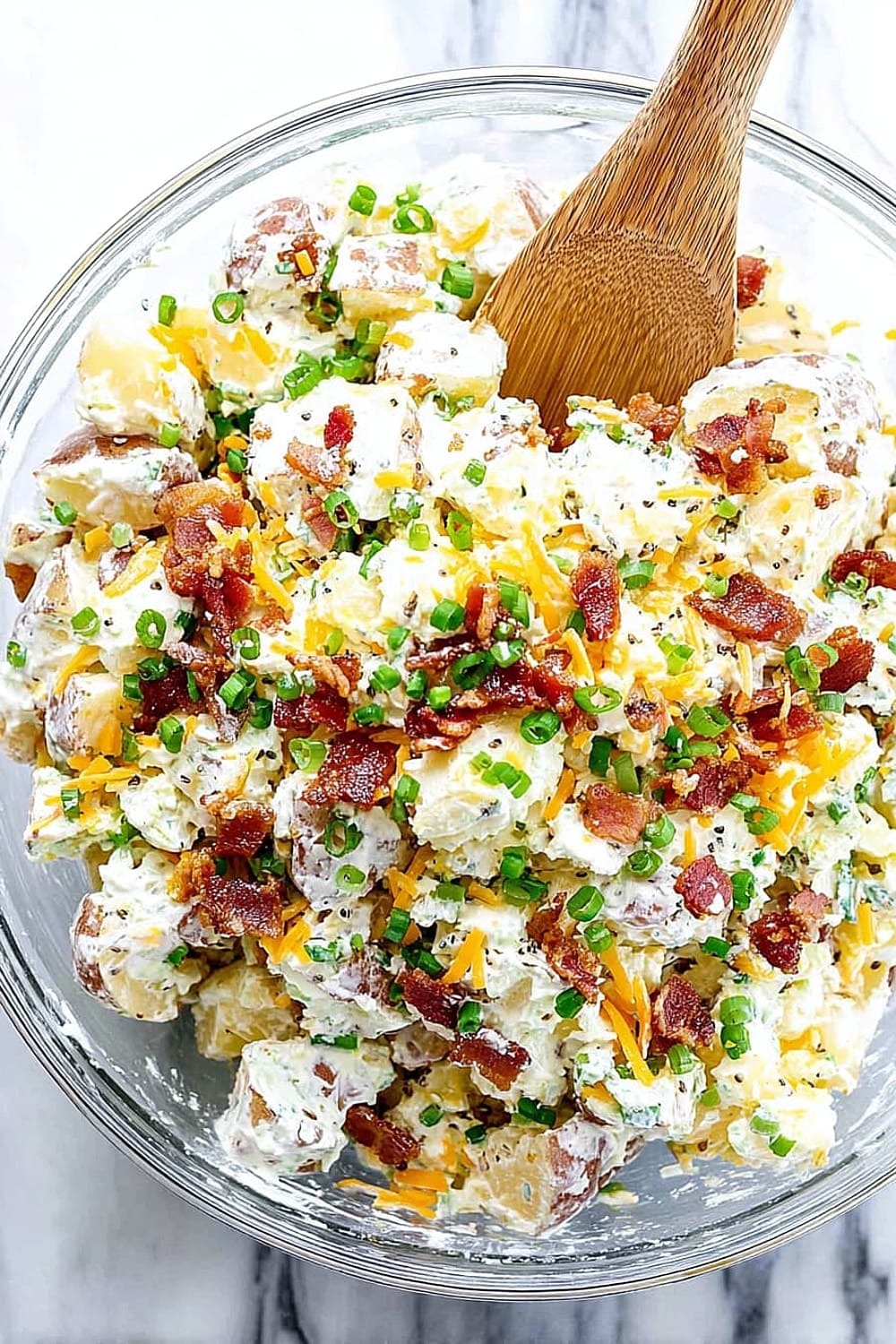
Recommended Equipment and Kitchen Tools
Recommended Tools (for best results):
- Large rimmed baking sheet – Essential for even potato roasting without rolling around
- Sharp cake tester or metal skewer – Perfect for checking potato doneness without creating large holes
- Large mixing bowl – You’ll need plenty of room to fold ingredients without making a mess
- Cast iron skillet – Provides even heat distribution for perfectly crispy bacon every time
Helpful Upgrades:
- Kitchen scale – For precise potato portions if you’re scaling the recipe up or down
- Silicone spatula set – Gentle folding prevents breaking up the potato chunks too much
- Instant-read thermometer – Takes the guesswork out of perfectly baked potatoes at 210°F (99°C)
- Microplane grater – Ideal if you want to add fresh cheese instead of pre-shredded
Nice-to-Have Options:
- Parchment paper – Makes cleanup easier when cooking bacon in the oven
- Large storage containers – Perfect for meal prep or transporting to gatherings
- Bench scraper – Helpful for transferring chopped ingredients efficiently
Remember, great potato salad can absolutely be made with basic kitchen tools – these recommendations just make the process smoother and more enjoyable!
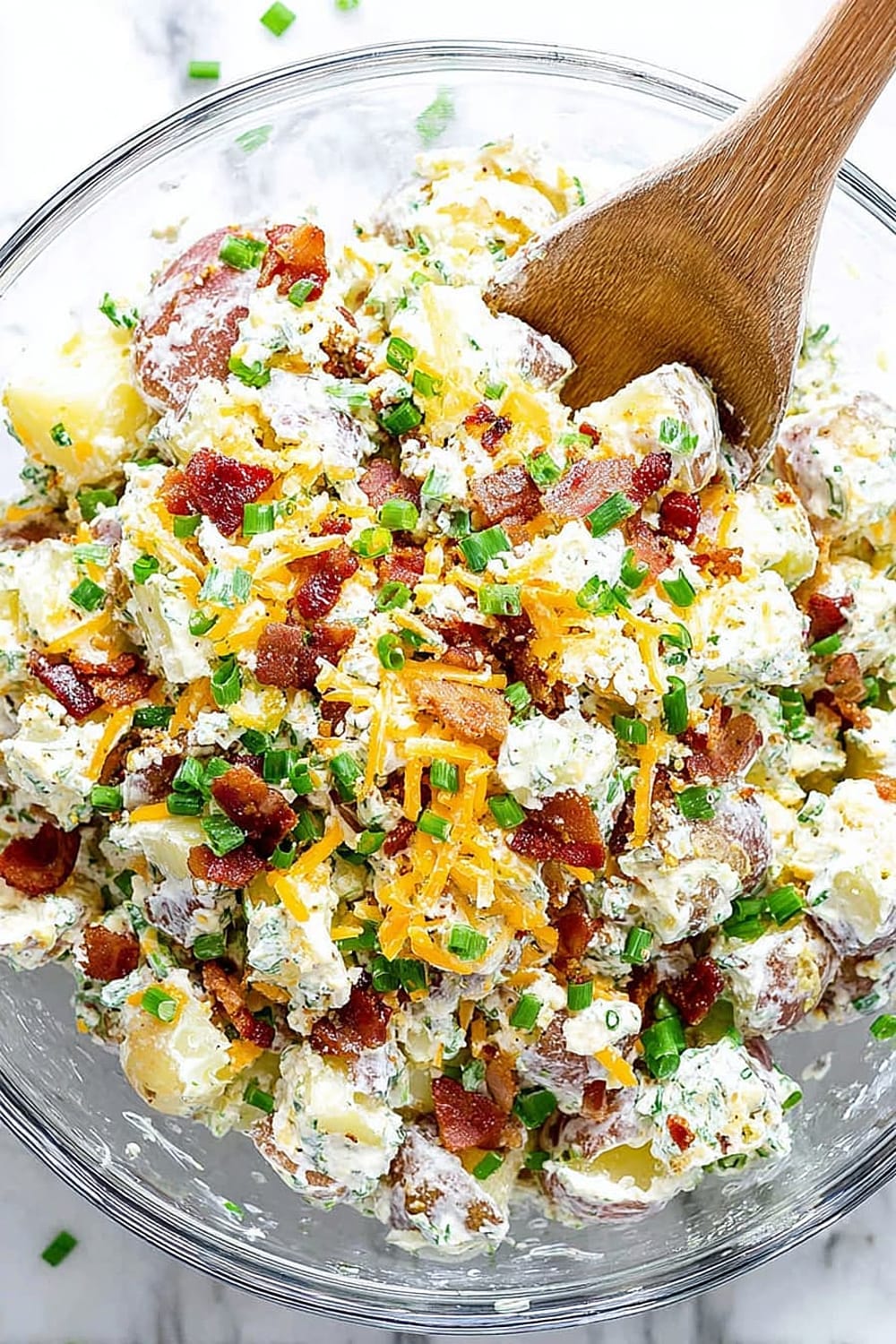
Recipe Variations and Dietary Modifications
Dairy-Free Modifications:
- Replace sour cream with ¾ cup dairy-free Greek yogurt alternative or additional mayonnaise
- Substitute cheddar cheese with 1½ cups nutritional yeast for cheesy flavor, or omit entirely
- Use vegan mayonnaise made with avocado oil for the creamiest texture
- Add extra green onions and fresh herbs to boost flavor without dairy
Lower-Fat Version:
- Replace half the mayonnaise with ½ cup plain Greek yogurt for protein boost
- Use turkey bacon instead of regular bacon to reduce saturated fat
- Reduce cheese to ¾ cup and add diced celery for crunch
- Include fresh dill and chives for extra flavor without calories
Loaded Variations:
- Steakhouse Style: Add diced grilled steak, blue cheese crumbles, and caramelized onions
- Tex-Mex Twist: Include jalapeños, pepper jack cheese, cilantro, and lime juice
- German-Inspired: Use warm bacon fat in dressing, add dill pickles and fresh dill
- Breakfast Style: Include hard-boiled eggs, breakfast sausage, and chives
Seasonal Adaptations:
- Summer: Add fresh corn kernels, cherry tomatoes, and basil
- Fall: Include roasted butternut squash cubes and sage
- Spring: Fresh peas, asparagus pieces, and lemon zest
- Winter: Roasted Brussels sprouts and dried cranberries
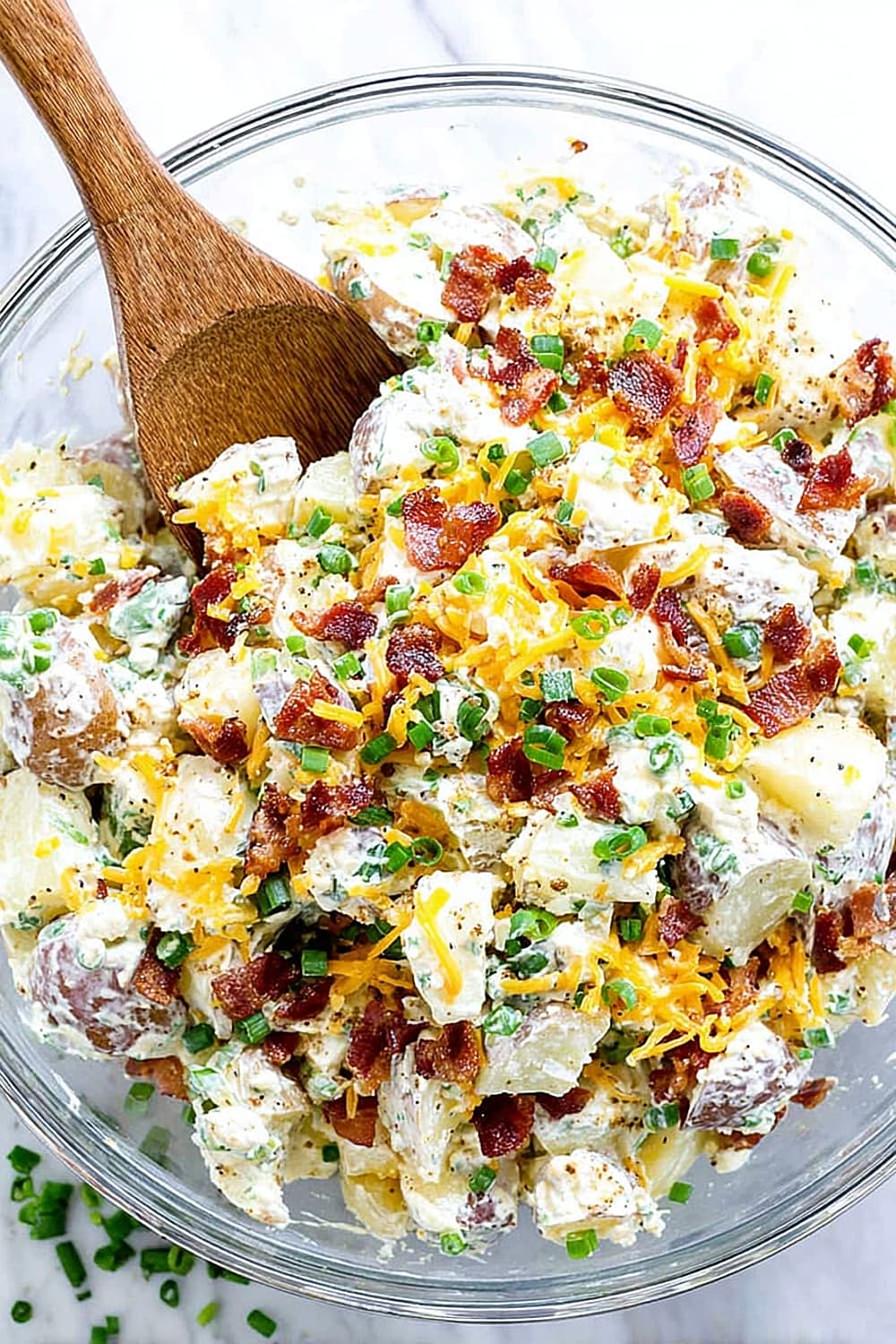
Nutritional Information and Health Benefits
Key Nutritional Highlights:
This loaded baked potato salad provides approximately 463 calories per serving when divided into 12 portions. Each serving delivers a satisfying combination of complex carbohydrates from the russet potatoes, high-quality protein from the bacon and cheese, and beneficial fats from the mayonnaise and sour cream. The potatoes contribute significant potassium (about 600mg per serving), while the dairy components add calcium and protein for bone health.
Health Benefits of Main Ingredients:
Russet potatoes are nutritional powerhouses, providing vitamin C, potassium, and resistant starch when cooled, which supports digestive health. The bacon contributes high-quality complete protein and essential B vitamins, particularly B12 and niacin. Cheddar cheese adds calcium, phosphorus, and vitamin A, while green onions provide antioxidants, vitamin K, and anti-inflammatory compounds. The apple cider vinegar may help with blood sugar regulation and adds probiotics if using raw, unfiltered varieties.
Dietary Considerations:
This recipe contains dairy, eggs (in mayonnaise), and pork, making it unsuitable for vegan, vegetarian, or those avoiding these allergens. The high calorie and fat content makes it best enjoyed in moderate portions as part of a balanced meal. The potassium content makes it beneficial for heart health, while the protein content helps with satiety and muscle maintenance.

Smart Swaps and Ingredient Substitutions
Common Substitutions:
- Russet potatoes → Yukon Gold potatoes (creamier texture, less fluffy)
- Mayonnaise → Greek yogurt for half the amount (tangier, lighter)
- Sour cream → Crème fraîche (richer flavor) or additional Greek yogurt
- Apple cider vinegar → White wine vinegar or rice vinegar (milder tang)
Budget-Friendly Swaps:
- Bacon → Turkey bacon or ham pieces (less expensive, lower fat)
- Medium cheddar → Sharp cheddar in smaller amounts (more flavor impact)
- Green onions → Regular yellow onion, finely diced (sharper bite)
- Olive oil → Vegetable oil for roasting (neutral flavor, lower cost)
Pantry Emergency Substitutions:
- Fresh green onions → 2 tablespoons dried chives or onion powder
- Shredded cheddar → Any hard cheese you have on hand, grated
- Apple cider vinegar → Lemon juice or white vinegar (start with less)
- Sour cream → Heavy cream mixed with lemon juice (let sit 5 minutes)
Pro Tips for Substitutions:
- When using Greek yogurt instead of sour cream, choose full-fat versions for best texture
- If substituting different potato varieties, adjust cooking time as waxy potatoes cook faster
- Store leftover bacon fat in the refrigerator – it keeps for months and adds incredible flavor to future dishes
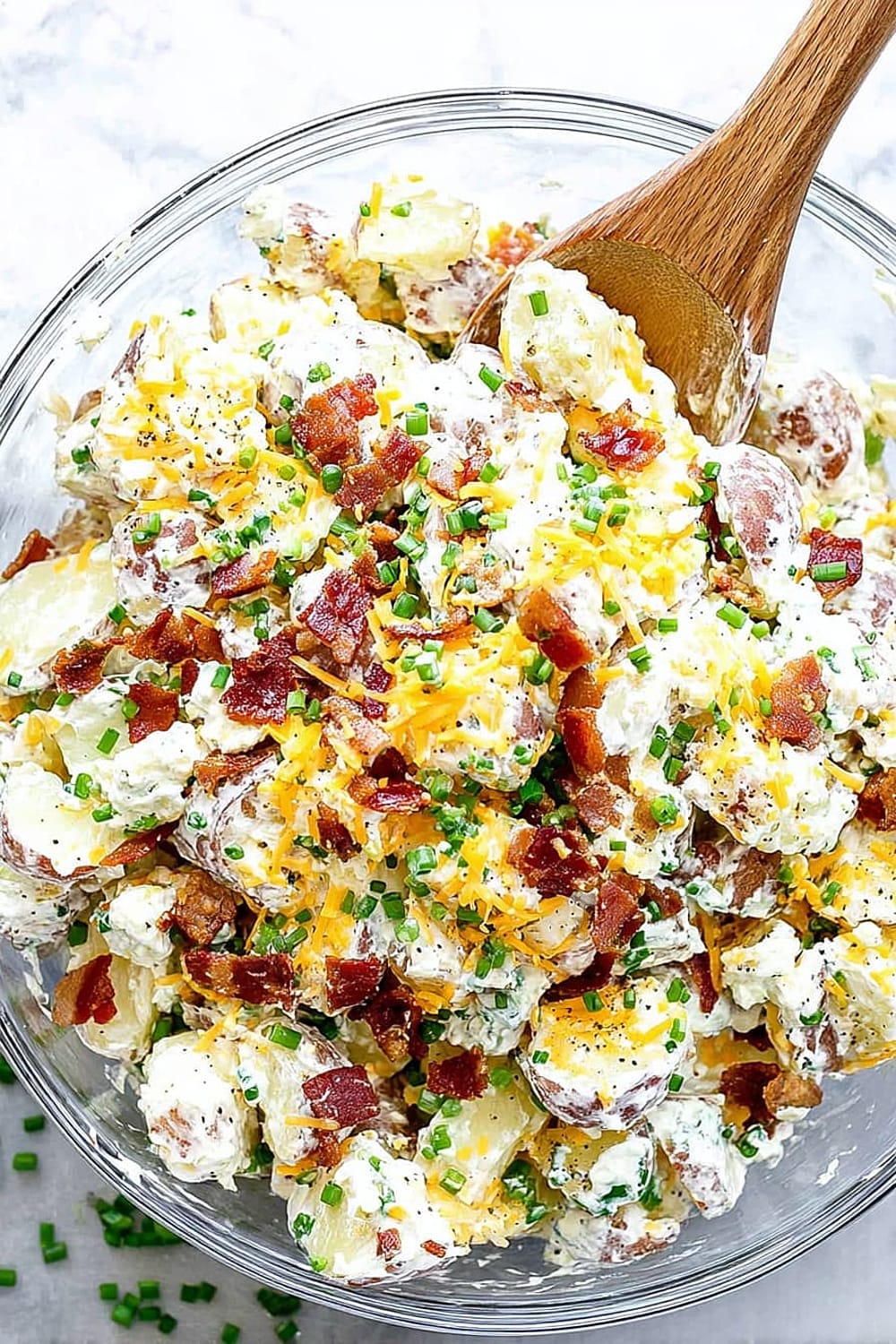
Make It Diabetes-Friendly
Carb Reduction Strategies:
- Replace 2 pounds of the potatoes with 2 pounds cauliflower florets, roasted until tender
- Use ½ cup mayonnaise mixed with ½ cup Greek yogurt to reduce calories while maintaining creaminess
- Reduce total serving size and pair with a large green salad to increase fiber and nutrients
- Choose reduced-fat sharp cheddar to get maximum flavor with less saturated fat
Smart Portion Control:
- Aim for ½ cup servings instead of larger portions to keep carbs around 15-20 grams per serving
- Serve alongside grilled protein and non-starchy vegetables for balanced blood sugar response
- The protein from bacon and cheese helps slow carbohydrate absorption
- Consider this a special occasion dish rather than everyday fare
Blood Sugar Friendly Tips:
- Add 2 tablespoons chopped fresh herbs like parsley or dill for extra flavor without carbs
- Include ½ cup diced celery for crunch and fiber with minimal carb impact
- Eat this salad after consuming protein or healthy fats to minimize blood sugar spikes
- The apple cider vinegar may help with post-meal glucose response
Total Carb Reduction: Using the cauliflower substitution reduces carbs by approximately 40% while maintaining the loaded potato salad experience.
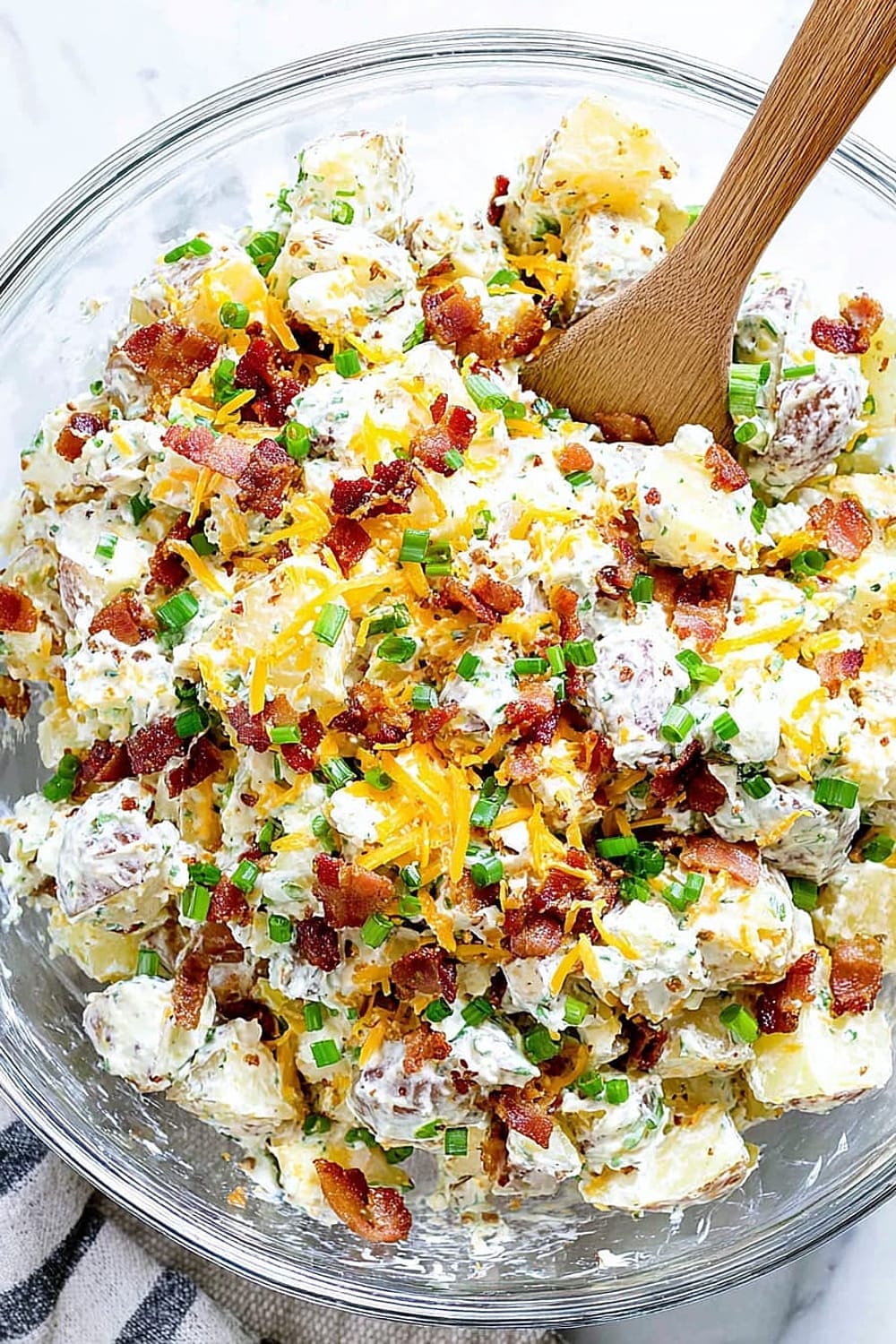
Perfect Pairing Suggestions
Beverage Pairings:
This rich, creamy potato salad pairs beautifully with crisp, refreshing beverages that cut through the richness. Try a cold German wheat beer or Belgian witbier for classic comfort food harmony. For wine lovers, a Sauvignon Blanc or Pinot Grigio provides the perfect acidic counterpoint. Non-alcoholic options include sparkling water with lemon, iced tea, or fresh lemonade to cleanse the palate between bites.
Side Dish Recommendations:
Balance this hearty salad with lighter, fresher options. Grilled asparagus or roasted Brussels sprouts add welcome vegetables and slight bitterness. A crisp coleslaw with vinegar-based dressing provides textural contrast, while fresh corn on the cob doubles down on the comfort food theme. Pickled vegetables or dill pickle spears cut through the richness perfectly.
Complete Meal Ideas:
This loaded potato salad shines at backyard barbecues alongside grilled burgers, pulled pork, or barbecue chicken. For casual entertaining, pair with grilled hot dogs and watermelon slices. It’s also perfect for potluck dinners, family reunions, and picnic spreads. Round out the meal with grilled corn, fresh fruit salad, and chocolate chip cookies for the ultimate comfort food feast.
Occasion Suggestions:
This recipe is ideal for Memorial Day through Labor Day gatherings, Fourth of July celebrations, and tailgate parties. It’s also perfect for casual dinner parties, church potlucks, and family game nights when you want something special but not fussy.
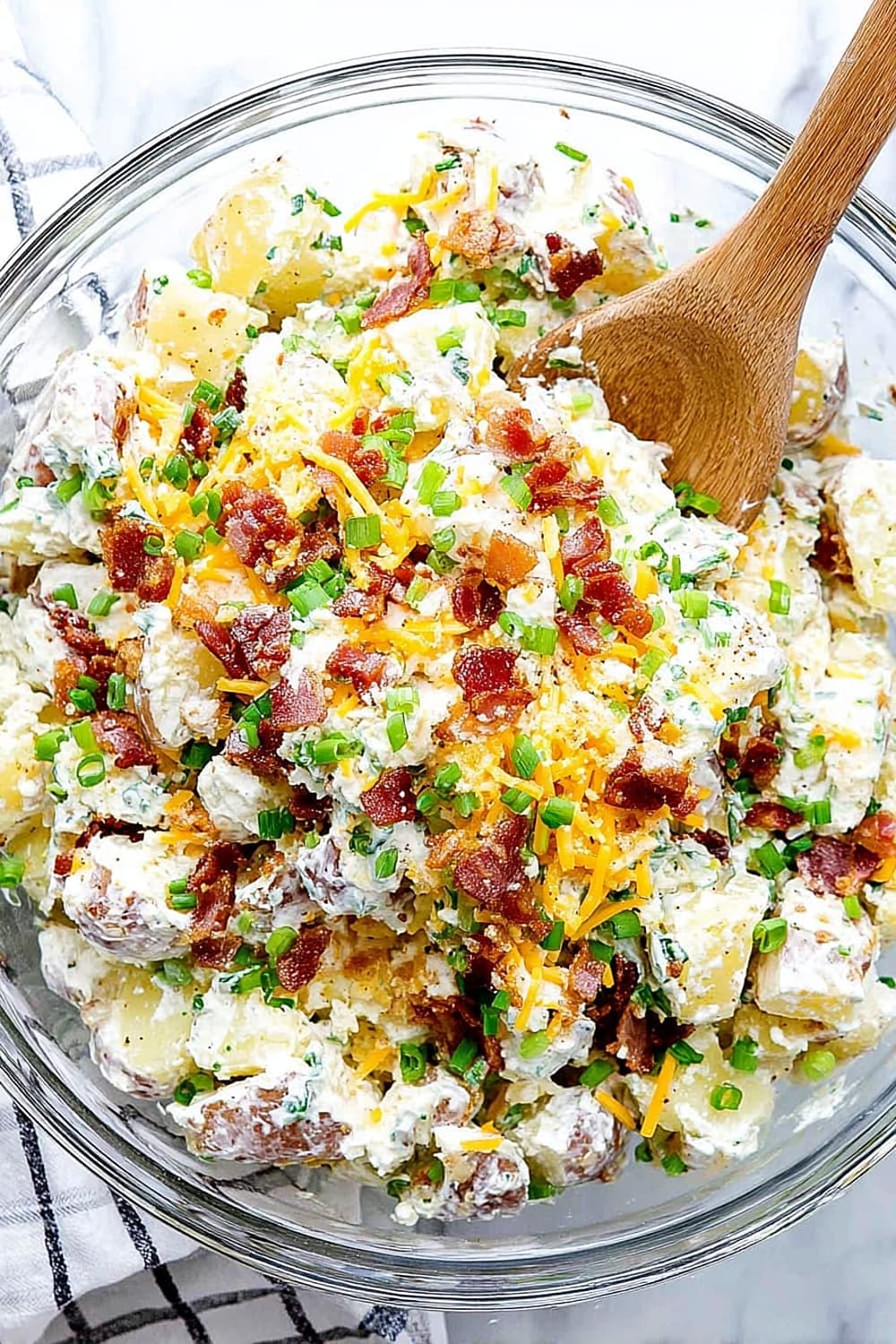
Pro Tips and Troubleshooting
Professional Techniques:
The key to exceptional potato salad lies in timing and temperature control. Always add the apple cider vinegar while potatoes are still warm – this creates deeper flavor penetration than cold seasoning. When folding ingredients, use a gentle lifting motion rather than stirring to maintain chunky potato texture. For the creamiest results, bring all dairy ingredients to room temperature before mixing, which prevents the dressing from seizing up.
Common Mistake Prevention:
Never add mayonnaise to hot potatoes, as it will break and become oily. Avoid over-mixing, which creates gluey, mashed potato texture instead of distinct chunks. Don’t skip the resting time – this salad truly improves after several hours as flavors meld together. When storing, press plastic wrap directly onto the surface to prevent oxidation and maintain color.
Make-Ahead Strategy:
This salad actually improves overnight, making it perfect for stress-free entertaining. Prepare everything except final seasoning up to 2 days ahead. Add extra salt and pepper just before serving, as flavors mellow during storage. For best texture, add half the green onions during initial mixing and reserve the rest for fresh garnish before serving.
Scaling and Storage:
This recipe easily doubles or triples for large gatherings – just use multiple baking sheets for the potatoes. Store in airtight containers for up to 4 days. The salad doesn’t freeze well due to the mayonnaise base, but leftovers make excellent loaded potato soup when thinned with chicken broth and heated gently.
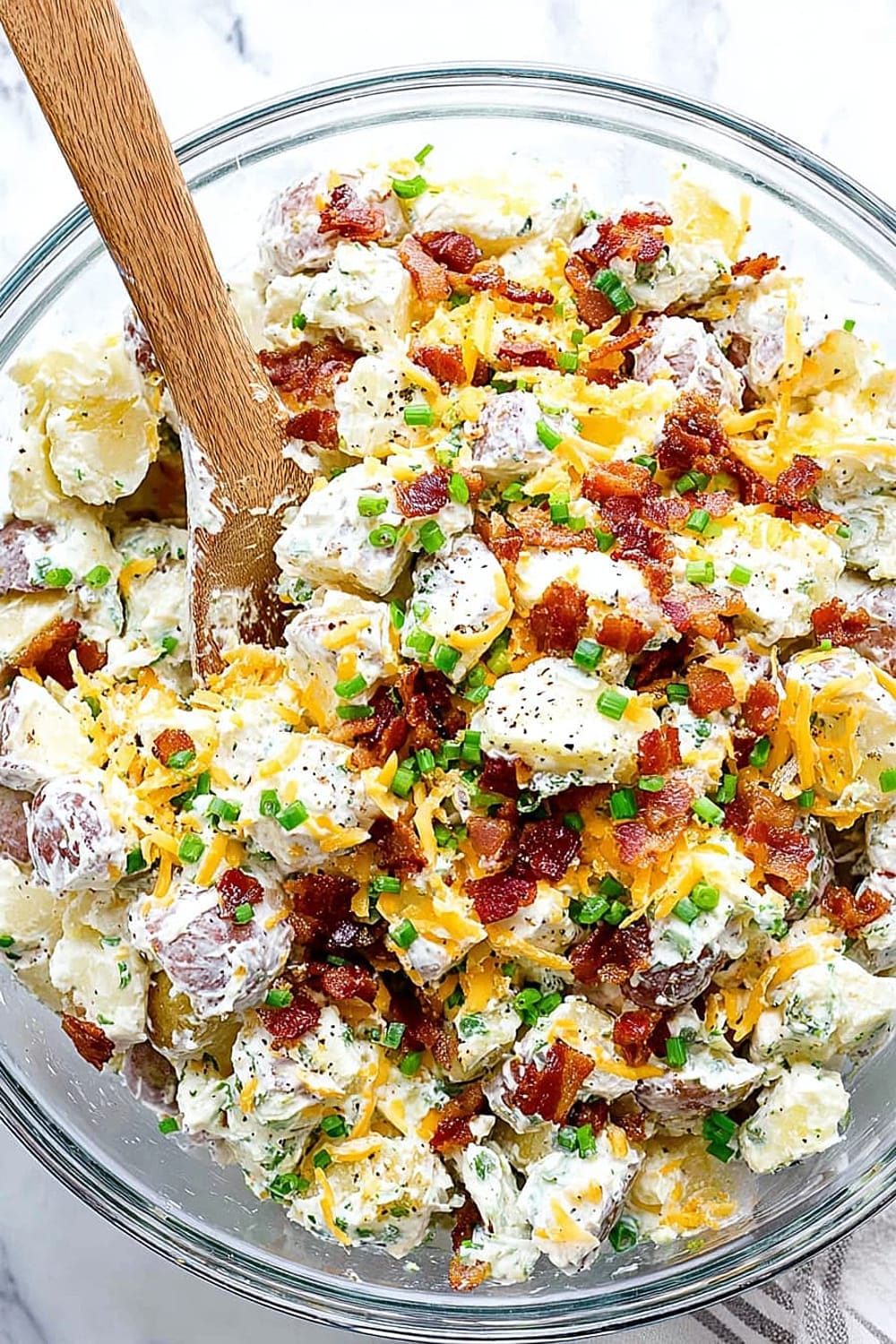
This loaded baked potato salad transforms a simple side dish into the star of any gathering, proving that sometimes the best recipes are just brilliant combinations of familiar favorites executed perfectly.